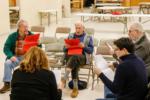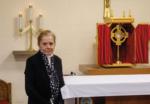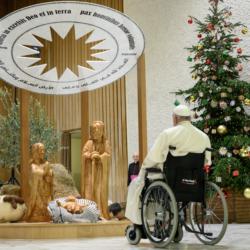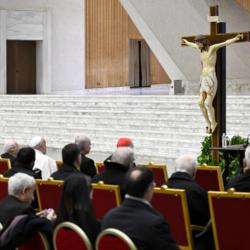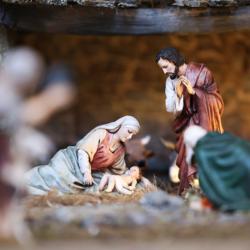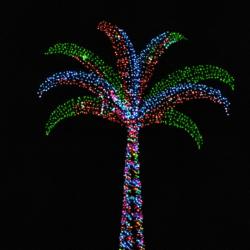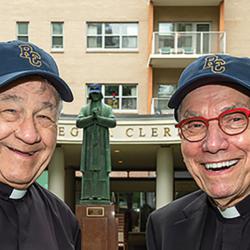Our Lady saved this remote Atlantic island from pirates -- here's how they honor her today
(OSV News) -- Our Lady's hands are said to have once repelled pirates from the small, secluded island of Corvo in the middle of the Atlantic Ocean.
Every year, on the Aug. 15 feast of the Assumption, the people of Corvo, the smallest of nine islands in the Azores, celebrate their patroness, Nossa Senhora dos Milagres ("Our Lady of Miracles" in Portuguese), with Mass, a procession and a daylong feast in the village.
People travel from the other islands, mainland Portugal and the United States on this day to pray in the small village church, where the 2-foot-tall image of Our Lady of Miracles is kept and venerated throughout the year.
They come to thank Our Lady for her intercession. Generations of Corvinhos have credited her with countless miracles. She has been a refuge in times of adversity, ever since it is said that she washed up on this island's rocky shores inside a wooden box, during the height of the Reformation in the 16th century.
Like most of the other Azorean islands, Corvo was vulnerable to pirate attacks throughout the middle of the last millennium. English privateers sacked the island in 1587 after laying waste to Flores, the nearest island to Corvo, according to official histories of the Azores.
In 1623, pirates from North Africa's Barbary Coast sailed into the channel between Flores and Corvo, poised to raid the island for its livestock and crops. The people, a population of fewer than 200, were unarmed; they could only throw rocks from the high cliff tops. They had no real means to resist. But that set the stage for Our Lady's most famous miracle in Corvo.
It was June 24, 1623, the feast of St. John the Baptist. Armed with cannon and musket, the pirates opened fire after sailing into the island's small rocky bay.
A letter written days later by the local vicar -- still kept in the Portuguese national archives in Lisbon -- tells the miraculous story of what is said to have happened next.
Father Ignacio Coelho wrote that he gathered from the island's coastal chapel a small statue of the Madonna and Child, which had been venerated as Nossa Senhora do Rosario -- Our Lady of the Rosary.
The statue itself was said to have a mysterious past. The island's oral tradition has it that the statue washed ashore inside a wooden crate, sometime during the 16th century. The statue -- believed to be Flemish in origin -- reportedly had a handwritten note around its neck: "Wherever you find me, build me a chapel." Saint statues washed up on the other islands' shores during the same time period.
As the pirates fired on the Corvinho settlement, Father Coelho wrote that he carried the image into battle and placed it atop a rocky outcropping near the port.
Despite the fact that the settlers were only armed with rocks, they prevailed, capturing several weapons and even a Moor who was part of the expedition, wrote Father Coelho.
A legend grew that the image of Our Lady miraculously deflected the pirates' gunfire, returning seven bullets for every one that they fired, and killing seven raiders with each round. The captured Moor is said to have declared that the pirates would never return to Corvo because the island was protected by a powerful "Margarida."
Several people gather to pray the rosary daily in the small village church. It is a tradition the people say began in thanksgiving for the image's divine assistance during the miraculous victory in 1623.
Our Lady is said to return their love, sometimes in extraordinary ways. The island's seniors still tell a story of how the image once showed its preference to remain forever on Corvo. During the 18th century, it is said the people of Faial, another one of the Azorean islands, wanted Nossa Senhora dos Milagres to visit and remain in their church.
However, signaling her desire to return to Corvo, the image would supposedly have her back turned to the congregation every morning when the church was opened. The statue would also be damp, which was interpreted as Our Lady's intention that she be shipped back across the water to Corvo.
Every year, the Corvinhos prepare themselves to celebrate their patroness by praying a novena in the days leading up to the feast of the Assumption.
After the afternoon Mass the day before, the people make a procession with the image by candlelight to the island's old port, near the location where she was brought during the battle in 1623.
The old port is significant in another manner. It is where a group of worshippers from Flores, located 45 miles away, hoped to dock when they traveled during the 1940s to join in the feast. A violent storm sank their boat, the Mary Victoria, killing all on board. The Corvinhos honor their memory, as do many Flores residents who still make the pilgrimage every year.
During the early-morning hours of Aug. 15, volunteers lay down a carpet of flowers and painted sawdust that stretches from the church to the feast grounds, about a quarter-mile away. Mass is celebrated at 3 p.m., followed by a procession along the narrow, centuries-old brick streets. The people pray the rosary and sing hymns as they carry Our Lady, who is adorned with a golden rosary.
Meanwhile, Corvinhos who have immigrated to Massachusetts attend a special Mass at Our Lady of Mount Carmel in New Bedford, followed by a reunion meal at a local restaurant. A replica of Nossa Senhora dos Milagres is brought to the church, and the image is lent to people throughout the year for family devotions at home.
Back on Corvo, everyone stops partying when it is announced later that night that Our Lady will be leaving the feast grounds. As the image is about to be carried back to the church, the people all stand up and sing a local hymn, "Good night Mary."
When she is out of view, the party resumes.
- - - Brian Fraga is a Catholic journalist who has written for several publications in the Catholic Press, including Our Sunday Visitor, the National Catholic Register, US Catholic, and Columbia. He is currently a staff writer for the National Catholic Reporter.






